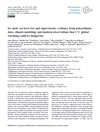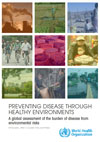-
A More Extreme Sea-Level Rise Scenario, and the Global Environmental Burden of Disease
April 13, 2016 By Haodan "Heather" Chen Though governments have agreed to try to limit global warming to no more than two degrees Celsius above pre-industrial levels, a paper by James Hansen et al. in Atmospheric Chemistry and Physics finds that goal may not prevent major changes on an irreversible and unadaptable scale. Studying the last interglacial period, about 120,000 years ago, when the temperature was less than one degree Celsius warmer than today, Hansen et al. estimate sea level was six to nine meters higher than today. Ice melting can lead to large-scale, rapid ice-sheet disintegration, the authors write, potentially leading to several feet of sea-level rise over the next 50 years, a much more extreme scenario than those established by the Intergovernmental Panel on Climate Change. “We are in a position of causing near irreparable harm to our children, grandchildren, and future generations,” says Hansen in video abstract of the paper. “This is a tragic situation because it is unnecessary. We could already been phasing out fossil fuel emissions if only we stop allowing the fossil fuel industry to use the atmosphere as a free dumping ground for their wastes.”
Though governments have agreed to try to limit global warming to no more than two degrees Celsius above pre-industrial levels, a paper by James Hansen et al. in Atmospheric Chemistry and Physics finds that goal may not prevent major changes on an irreversible and unadaptable scale. Studying the last interglacial period, about 120,000 years ago, when the temperature was less than one degree Celsius warmer than today, Hansen et al. estimate sea level was six to nine meters higher than today. Ice melting can lead to large-scale, rapid ice-sheet disintegration, the authors write, potentially leading to several feet of sea-level rise over the next 50 years, a much more extreme scenario than those established by the Intergovernmental Panel on Climate Change. “We are in a position of causing near irreparable harm to our children, grandchildren, and future generations,” says Hansen in video abstract of the paper. “This is a tragic situation because it is unnecessary. We could already been phasing out fossil fuel emissions if only we stop allowing the fossil fuel industry to use the atmosphere as a free dumping ground for their wastes.” The World Health Organization has released an updated report on the burden of disease from environmental factors. Reviewing the last decade, the report shows that more than 100 of world’s most dangerous diseases and injuries, which account for 12.6 million deaths every year (one fourth of all deaths), are avoidable and related to environmental risks. One of the primary findings is that there has been a shift away from infectious and parasitic diseases, like malaria and tuberculosis, to non-communicable diseases, like cancer and strokes. This may indicate a reduction of environmental risks causing infectious diseases such as poor water, sanitation, and waste management but an increasing influence of air pollution on public health. According to the report, environmental factors are responsible for 25 percent of strokes, the top killer of all of environment-related diseases. Other findings include a regional imbalance of deaths related to the environment: most of the diseases, especially infectious and parasitic, occur in sub-Saharan Africa while other regions have higher per capita rates of non-communicable diseases.
The World Health Organization has released an updated report on the burden of disease from environmental factors. Reviewing the last decade, the report shows that more than 100 of world’s most dangerous diseases and injuries, which account for 12.6 million deaths every year (one fourth of all deaths), are avoidable and related to environmental risks. One of the primary findings is that there has been a shift away from infectious and parasitic diseases, like malaria and tuberculosis, to non-communicable diseases, like cancer and strokes. This may indicate a reduction of environmental risks causing infectious diseases such as poor water, sanitation, and waste management but an increasing influence of air pollution on public health. According to the report, environmental factors are responsible for 25 percent of strokes, the top killer of all of environment-related diseases. Other findings include a regional imbalance of deaths related to the environment: most of the diseases, especially infectious and parasitic, occur in sub-Saharan Africa while other regions have higher per capita rates of non-communicable diseases.Sources: Atmospheric Chemistry and Physics, Guardian, The New York Times, World Health Organization.
Video Credit: James Hansen provides a video abstract of the Atmospheric Chemistry and Physics paper, courtesy of David Schumacher/YouTube.
 A Publication of the Stimson Center.
A Publication of the Stimson Center.





